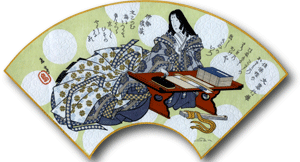Posted by Dave Bull at 5:50 PM, June 4, 2004
 So, for only the third time in my career, here I am introducing the first print in a new series! After spending ten years on the Hyakunin Isshu poetry prints and five years on Surimono Albums, it's going to be interesting to try my hand at a different kind of print this year. But having said that, I have to admit that this first one wouldn't have been completely out of place in either of those two previous print series - it of course represents a Heian-era woman preparing to write a poem card, and yet is also a classic example of an Edo-era surimono, with its combination of poetry and image.
So, for only the third time in my career, here I am introducing the first print in a new series! After spending ten years on the Hyakunin Isshu poetry prints and five years on Surimono Albums, it's going to be interesting to try my hand at a different kind of print this year. But having said that, I have to admit that this first one wouldn't have been completely out of place in either of those two previous print series - it of course represents a Heian-era woman preparing to write a poem card, and yet is also a classic example of an Edo-era surimono, with its combination of poetry and image.
The seal and signature over at the left tell us that this is a design by Yashima Gakutei, creator of some of the finest surimono, and although the exact date of this print is unknown, it would seem to be from the 1820's. Fan-shaped surimono were quite rare, perhaps because of the incongruity involved - fan prints were utterly disposable items, while most surimono were carefully crafted and treasured. I presume though, that the original of this print was never intended to be actually pasted onto a fan ... and I certainly hope that you feel the same way!
And now ... what should be the topic for this little story to accompany the first print in my 'Beauties of Four Seasons' series? Well I think it's obvious ... I'm sure a number of the collectors of this series are already scratching their heads and saying to themselves "Dave, when you announced you were going to make a series of prints of beautiful women, I assumed that you would ... um, you know ... choose beautiful women!" Yes, the question has to be "Is this woman beautiful?"
Discussions about the meaning of beauty usually get involved with such concepts as 'inner beauty', but traditional Japanese woodblock prints were, for the most part, purely decorative items, and were not intended to carry involved psychological interpretations. I think when it comes to the case of bijin-ga (woodblock prints of beautiful women) we are really only talking about the simplest level ... the attractiveness of the elements that we can see: the clothing, and those few parts of the lady that are visible - her hair and face. The nearest equivalent in our contemporary society would be such things as fashion magazines or cosmetic advertisements; the idea is simply to make us feel "Oh, how beautiful!", without thinking too deeply about it.
The subjects of typical bijin-ga are almost without exception, young, fresh and clear-skinned, and conform closely to society's image of ideal 'beauty'. And very interestingly, that seems to quite dramatically change from era to era. We all know that clothing fashions change over time - over weeks it seems, let alone years - but it is also true that a woman who might be considered very beautiful in one era might not get a second glance in another.
This was brought home to me very vividly one day some years back while I was riding the subway here in Tokyo. Seated across from me was a young lady who looked exactly as though she had been the model for any number of Utamaro print designs. Her face was quite long, her mouth quite small, and just exactly what other visual characteristics she had I couldn't clearly put my finger on, but there was no doubt about it - this woman's great-great-great-grandmother surely had posed for Utamaro!
But what was most interesting, this woman - who was the perfect image of some of the most famous bijin-ga ever created - wasn't actually so attractive to modern eyes. Yet at one time she must have been the epitome of feminine beauty.
Another barrier to our appreciation of the 'beauty' in these prints is the strange - to our contemporary eyes - cosmetic practice of shaving the eyebrows and replacing them with painted marks up on the forehead. I can't understand how anybody ever thought this was beautiful, but I'm sure people in a future era will look back on some of the things that young women do with makeup today and say exactly the same thing.
As with any time that we try and understand a work of art from another era (or book, or musical composition), we have to learn to see it with eyes attuned to that era's sensibilities. That's impossible of course, as "The past is a different country ...", but if nothing else, looking at a print like this gives us some insight into the way "... they do things differently there."
So there we have it - a print from the 1820's giving us a taste of feminine beauty of that era. The focus of course, is on the clothing, not the person, as was the standard practice of that era. Let's see how this focus changes as we progress though this series of four prints!
Thank you for joining my collectors' group this year - I hope you will enjoy the journey!
June 2004
